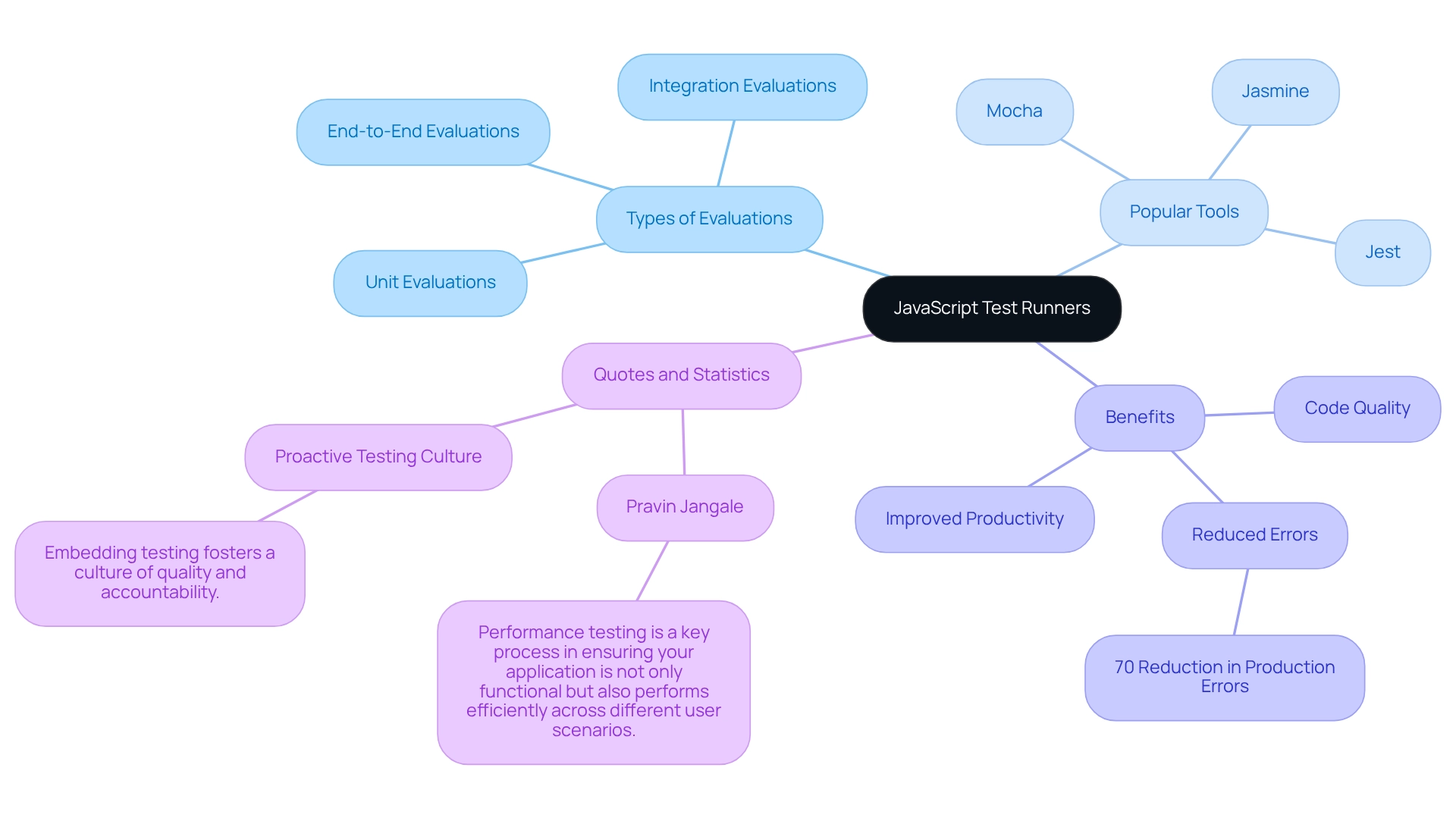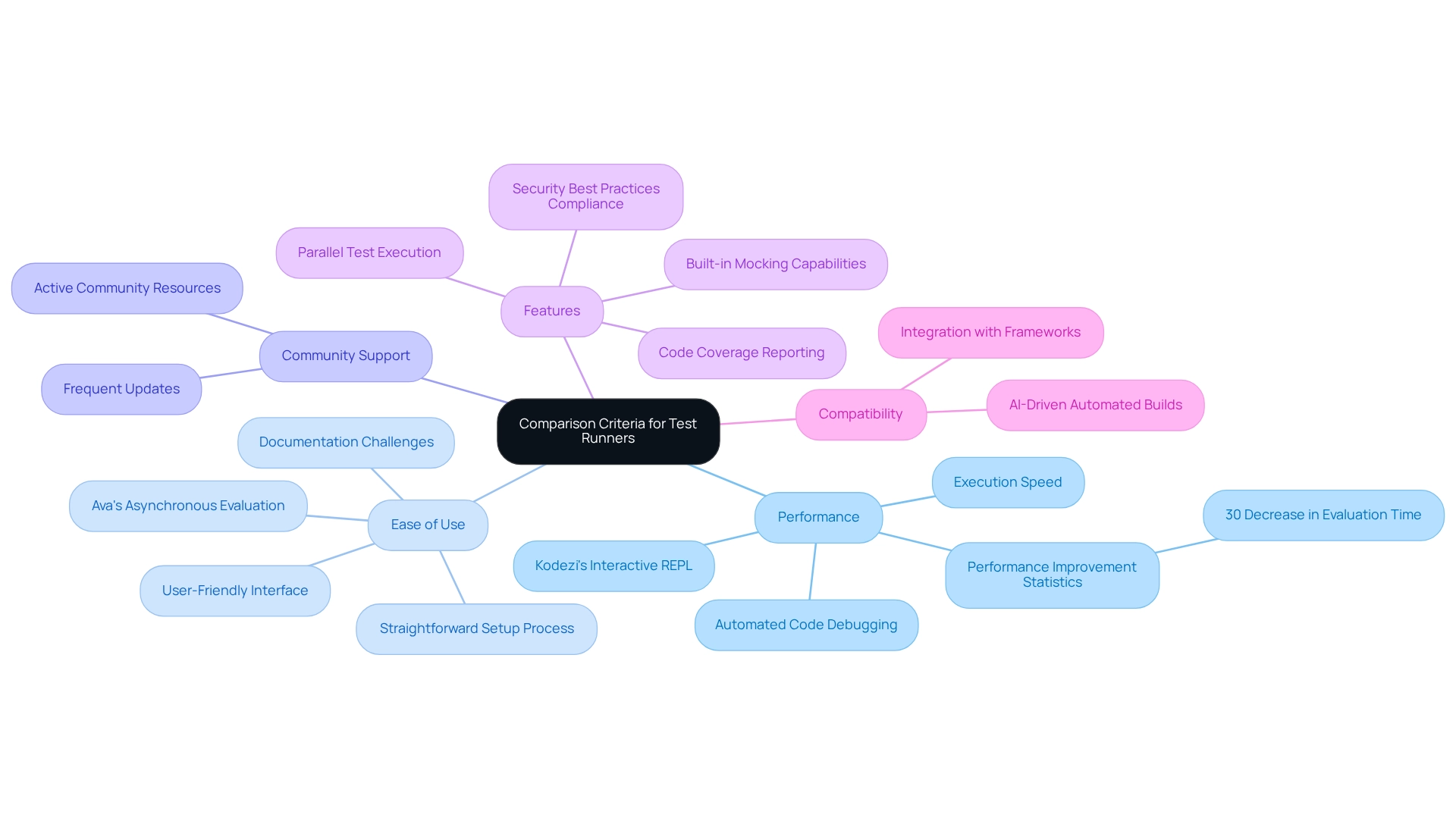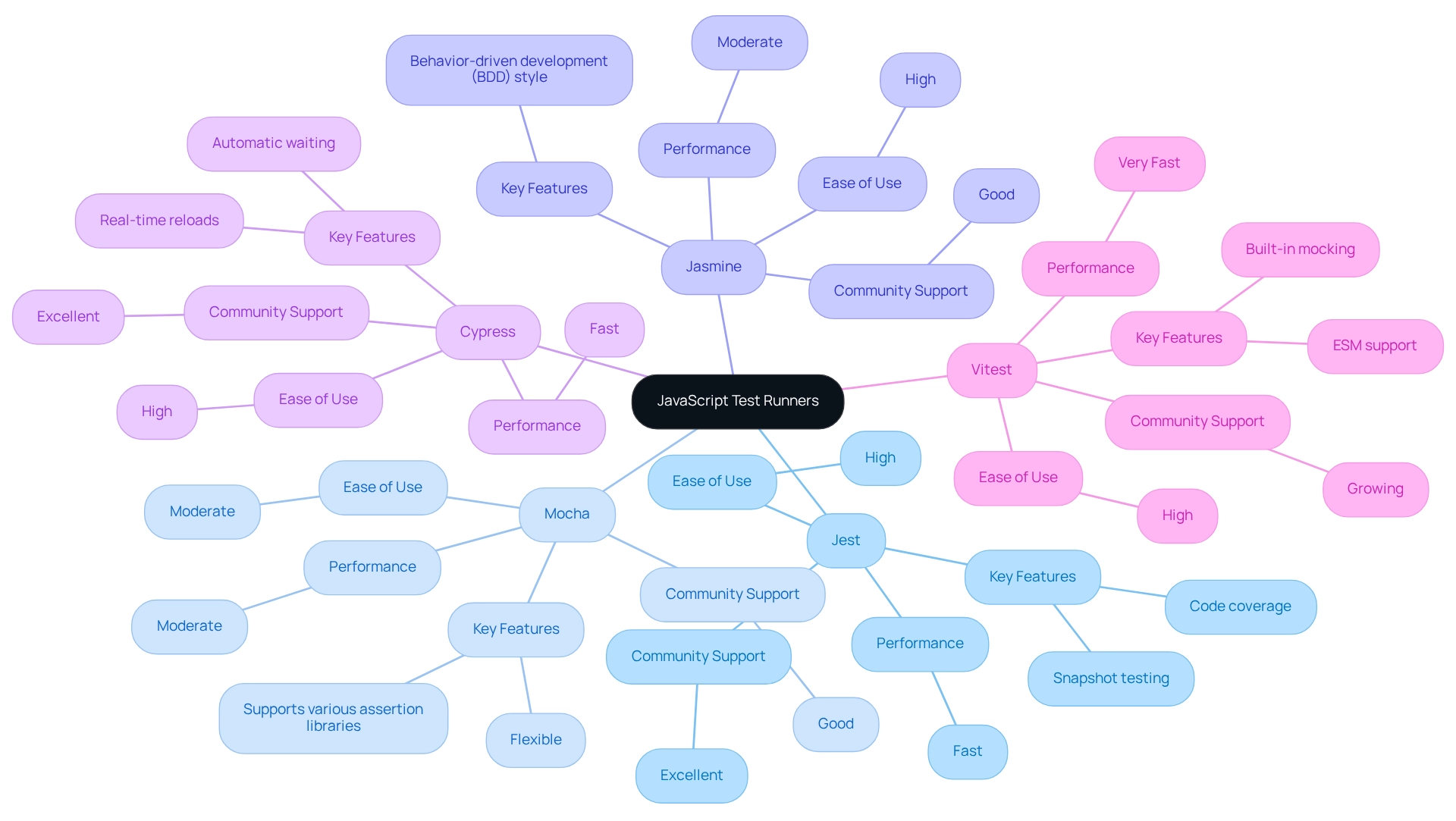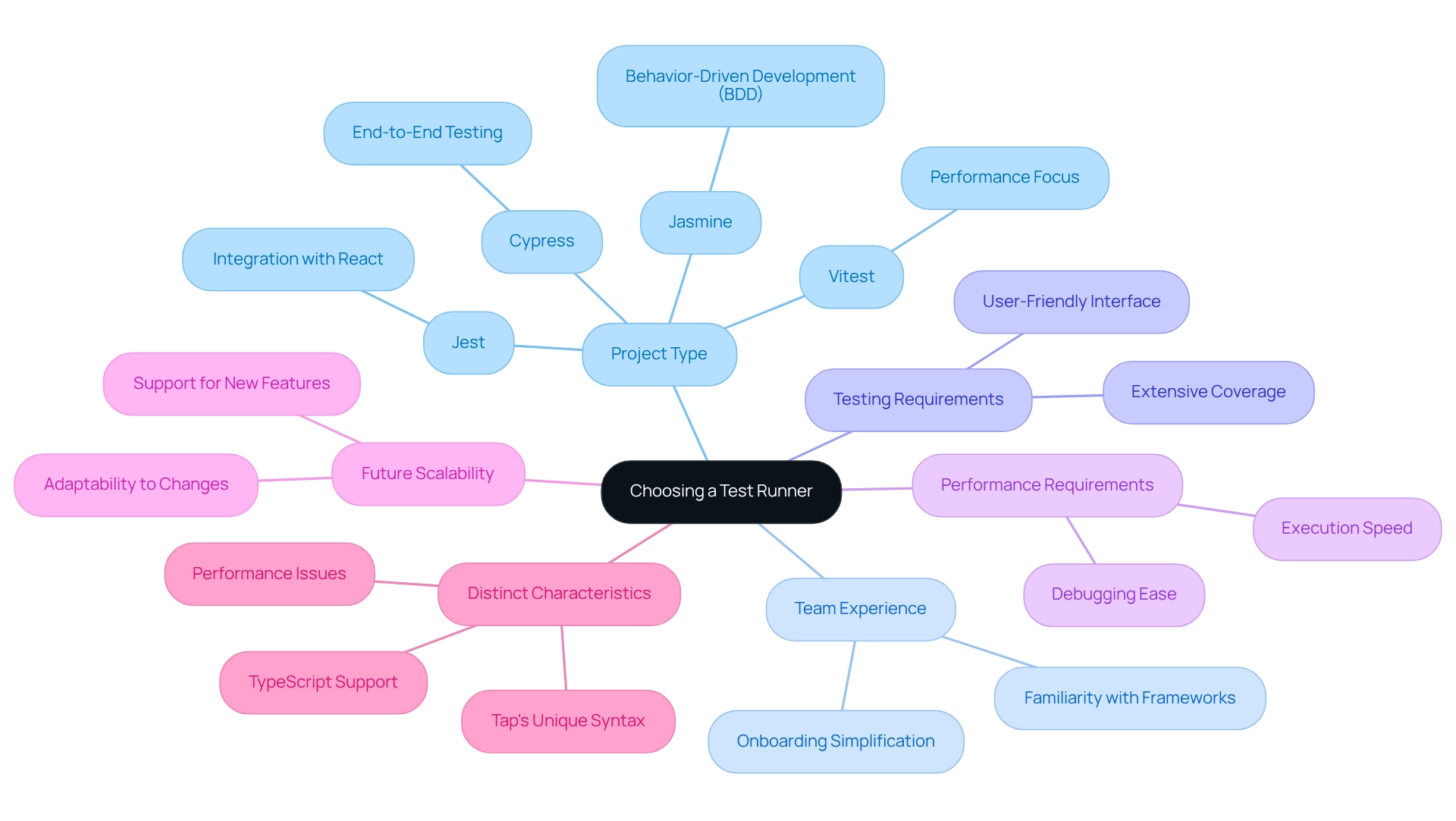Overview
The article highlights the challenges developers encounter in coding, particularly in maintaining code quality and efficiency. It presents five essential JavaScript test runner tools that automate the testing process, ultimately enhancing development efficiency. Selecting the right test runner is crucial, and factors such as performance, ease of use, community support, and specific project requirements play a significant role in this decision. Tools like Jest, Mocha, and Cypress cater to diverse testing needs, showcasing how they can significantly reduce production errors. By understanding these tools, developers can improve their coding practices and ensure higher quality outputs.
Introduction
In the ever-evolving landscape of software development, have you ever considered the coding challenges developers face? The significance of JavaScript test runners cannot be overstated. These powerful tools automate the testing process, ensuring that applications meet quality standards while streamlining the development lifecycle. As organizations increasingly recognize the value of comprehensive testing practices, the adoption of test runners has surged. Options like Jest, Mocha, and Cypress are leading the charge.
Furthermore, by delving into the unique features, performance metrics, and community support of these tools, developers can make informed choices that enhance productivity and minimize errors. Imagine the benefits of improved code quality and a culture of accountability in your projects. By embracing these tools, you can foster a more efficient development process that ultimately leads to greater success.
Understanding JavaScript Test Runners
JavaScript evaluation tools serve as a test runner JavaScript, which are essential instruments that automate the execution of assessments within JavaScript applications. They streamline the process of conducting unit evaluations, integration evaluations, and end-to-end evaluations. By managing the entire lifecycle of tests—including setup, execution, and teardown—these tools ensure that code behaves as expected and meets quality standards. Furthermore, they provide comprehensive reports on evaluation results, which are crucial for detecting problems early in the development process.
In extensive codebases, where manual evaluation can be ineffective and prone to mistakes, execution tools play a pivotal role in upholding code quality. Popular choices like Jest, Mocha, and Jasmine offer distinct features tailored for different assessment requirements, enabling developers to select the most suitable test runner JavaScript option for their projects. The importance of JavaScript test runners is underscored by the fact that organizations adopting thorough evaluation methods can reduce production errors by as much as 70%, as highlighted in the case study titled 'Proactive Testing Culture.' This research illustrates how incorporating evaluation into the development process fosters a culture of quality and accountability among team members, significantly enhancing customer satisfaction and trust.
As Pravin Jangale, a Software Engineer at NCR Atleos, states, 'Performance testing is a key process in ensuring your application is not only functional but also performs efficiently across different user scenarios.' Recent statistics indicate a growing adoption of test runner JavaScript in software development, underscoring their vital role in maintaining code quality. Developers emphasize that utilizing testing tools not only boosts the reliability of applications but also enhances overall productivity. This allows teams to focus on creating innovative solutions rather than addressing issues post-deployment. This proactive approach to testing is increasingly recognized as a crucial element in successful software development, aligning with the notion that considering multiple options for each significant design decision leads to better outcomes.

Comparison Criteria for Test Runners
When it comes to coding, developers often encounter significant challenges that can impede their productivity. Evaluating a test runner JavaScript reveals several key criteria that are essential for ensuring optimal performance and user satisfaction. Performance and usability are paramount. The execution speed of assessments is crucial, as quicker evaluation processes lead to faster feedback loops, ultimately enhancing development efficiency. Did you know that runners with improved performance can decrease evaluation time by up to 30%? This allows developers to focus more on coding. For example, Kodezi includes an interactive REPL that enables developers to observe evaluations in real-time, further enhancing assessment efficiency. Furthermore, Kodezi's automated code debugging tools can instantly identify and fix codebase issues, swiftly addressing performance bottlenecks and enhancing code formatting, which complements the speed of test execution.
Ease of Use is another critical factor. A user-friendly interface and straightforward setup process are vital for minimizing the learning curve, especially for new developers. Test tools that prioritize usability often experience higher adoption rates and user satisfaction. Take Ava, for instance; it emphasizes asynchronous evaluation, improving usability, though it has faced criticism for its documentation. In addition, integrating automated debugging features can simplify the process by providing detailed explanations of issues, making it easier for developers to resolve problems quickly.
Community Support cannot be overlooked. A robust community significantly enhances the user experience by providing valuable resources, plugins, and troubleshooting assistance. Test runners with active communities tend to receive more frequent updates and improvements, contributing to their longevity and reliability.
Features play a crucial role as well. Advanced functionalities such as parallel test execution, code coverage reporting, and built-in mocking capabilities can greatly enhance assessment abilities. These features not only simplify the evaluation process but also improve the overall quality of the code. Moreover, Kodezi's automated code debugging ensures that the code complies with the latest security best practices and coding standards, further enhancing the reliability of the results.
Compatibility is also essential. The ability to integrate seamlessly with various frameworks and libraries is crucial. A verification executor that integrates smoothly into current workflows guarantees that developers can maintain productivity without major interruptions. Kodezi's AI-driven automated builds and testing capabilities enhance this integration, offering a more seamless creation experience.
As W. Edwards Deming stated, 'Quality is everyone's responsibility.' This emphasizes the significance of choosing an evaluation tool that not only meets performance criteria but also aligns with quality standards. By evaluating these criteria, developers can select the most appropriate test runner JavaScript that matches their project requirements and improves their overall efficiency. Explore the tools available on Kodezi’s platform to elevate your coding experience.

Comparative Analysis of the Top 5 JavaScript Test Runners
| Test Runner | Performance | Ease of Use | Community Support | Key Features | |-------------|---------------|--------------|------------------|-----------------------------------------------------| | Jest | Fast | High | Excellent | Snapshot testing, code coverage | | Mocha | Moderate | Moderate | Good | Flexible, supports various assertion libraries | | Jasmine | Moderate | High | Good | Behavior-driven development (BDD) style | | Cypress | Fast | High | Excellent | Real-time reloads, automatic waiting | | Vitest | Very Fast | High | Growing | ESM support, built-in mocking |
Coding challenges can be daunting for developers, particularly when it comes to testing frameworks. Kodezi offers solutions that streamline the testing process, making it easier to identify and resolve issues efficiently. For instance, Jest stands out for its speed and comprehensive feature set, making it a popular choice among React developers. Mocha is recognized for its versatility, often combined with various assertion libraries to enhance evaluation capabilities, as noted by community contributor Sharanya R.C. Similarly, Jasmine appeals to those who prefer a behavior-driven development (BDD) approach, while Cypress is lauded for its robust end-to-end testing features, including real-time reloading and automatic waiting. Vitest is rapidly gaining traction, especially in projects utilizing ES modules, thanks to its impressive performance and built-in mocking capabilities.
Furthermore, recent insights reveal that Jest is favored for UI evaluation over Jasmine, underscoring its effectiveness in real-world applications. Both Jest and Vitest offer distinct advantages, making them excellent choices for developers. Platforms such as Sauce Labs empower developers to leverage both frameworks without being restricted to one, ensuring scalable evaluation solutions. In addition, Japa still requires stabilization, which may affect its standing among the other options. Although Tap is actively maintained, it currently lacks compelling reasons for selection as a test runner in JavaScript. In summary, while the choice of a test runner JavaScript may not drastically impact overall evaluation effectiveness, understanding the unique features and community support of each can guide developers in selecting the best tool for their specific needs. Integrating Kodezi's automated code debugging capabilities can significantly enhance the testing process by ensuring rapid issue resolution, optimizing performance, and maintaining security compliance. For example, when utilizing Jest, Kodezi can assist in swiftly identifying and resolving performance bottlenecks. Similarly, with Cypress, it can ensure adherence to security best practices during end-to-end evaluations. This ultimately results in a more efficient production cycle.

Choosing the Right Test Runner for Your Development Needs
Choosing the right assessment tool is essential for overcoming coding challenges and enhancing development processes. It not only guarantees efficient evaluation but also streamlines the workflow. Several key factors should guide this decision:
- Project Type: How does the nature of your project influence your choice? For instance, Jest is often favored for React applications due to its seamless integration and high performance. Conversely, Jasmine excels in Behavior-Driven Development (BDD) evaluation, providing a clear framework for composing assessments.
- Team Experience: What impact does your team's familiarity with specific frameworks have on productivity? Selecting a runner that aligns with your team's existing expertise can simplify onboarding and reduce the learning curve, enabling faster implementation.
- Testing Requirements: Are you working on a project that demands extensive end-to-end testing? If so, consider Cypress, renowned for its robust features and user-friendly interface. Its capabilities ensure thorough assessment coverage across various scenarios.
- Performance Requirements: In extensive codebases with numerous evaluations, performance becomes crucial. Frameworks like Vitest, recognized for their speed, can significantly enhance efficiency by reducing execution times. Vitest's interface allows for executing individual evaluations or suites directly, facilitating easier debugging and enabling developers to focus on coding rather than waiting for evaluations to complete.
- Future Scalability: How important is it for your testing tool to adapt as your project evolves? A versatile execution framework will support new features and adjust to changes in project requirements, ensuring long-term viability and efficiency.
- Distinct Characteristics and Constraints: For example, while Tap offers a unique syntax and organized documentation, it has performance issues and lacks support for simultaneous testing, which may confuse users. Its TypeScript evaluation support is an advantage, but these factors should be considered thoughtfully.
By carefully weighing these factors, development teams can select a test runner that not only meets their current needs but also fosters future growth and enhances overall productivity. As Sujit Karpe, Co-Founder & CTO at iMocha, aptly puts it, "Performance testing is an art and science mixed together," underscoring the importance of thoughtful selection in achieving optimal results.

Conclusion
In the realm of software development, coding challenges are a constant hurdle for developers. JavaScript test runners have emerged as indispensable tools, streamlining the testing process and ensuring high code quality. By automating the execution of various types of tests—unit, integration, and end-to-end—these tools empower developers to identify issues early, significantly reducing errors and enhancing customer satisfaction. Popular runners like Jest, Mocha, and Cypress each possess unique strengths, catering to diverse project needs and developer preferences.
When selecting the right test runner, it is crucial to consider factors such as:
- Project type
- Team experience
- Performance requirements
A thoughtful choice can lead to improved productivity, reduced test execution times, and a more efficient development cycle. Furthermore, the importance of community support and advanced features cannot be overstated, as they contribute to a smoother user experience and ongoing improvements.
Ultimately, embracing JavaScript test runners fosters a culture of accountability and quality within development teams. By leveraging these tools effectively, organizations can enhance their testing practices and create an environment conducive to innovation and success. The proactive adoption of these testing frameworks is a strategic investment in the future of software development, ensuring that applications are not only functional but also efficient and reliable.
Frequently Asked Questions
What are JavaScript evaluation tools?
JavaScript evaluation tools are test runners that automate the execution of assessments within JavaScript applications, helping to conduct unit evaluations, integration evaluations, and end-to-end evaluations.
How do JavaScript evaluation tools benefit the testing process?
They streamline the entire lifecycle of tests, including setup, execution, and teardown, ensuring that code behaves as expected and meets quality standards. They also provide comprehensive reports on evaluation results, which help detect problems early in the development process.
Why are execution tools important in extensive codebases?
In large codebases, manual evaluation can be ineffective and prone to mistakes. Execution tools help uphold code quality by automating the testing process.
What are some popular JavaScript test runners?
Popular JavaScript test runners include Jest, Mocha, and Jasmine, each offering distinct features tailored for different assessment requirements.
How can thorough evaluation methods impact production errors?
Organizations that adopt thorough evaluation methods can reduce production errors by as much as 70%, fostering a culture of quality and accountability among team members.
What role does performance testing play in application development?
Performance testing ensures that applications are not only functional but also perform efficiently across different user scenarios, contributing to overall application reliability.
What are the benefits of utilizing JavaScript testing tools?
Utilizing testing tools boosts the reliability of applications, enhances overall productivity, and allows teams to focus on creating innovative solutions rather than addressing issues post-deployment.
Why is a proactive approach to testing recognized as crucial in software development?
A proactive approach to testing is increasingly recognized as vital because it aligns with the notion that considering multiple options for significant design decisions leads to better outcomes in successful software development.




